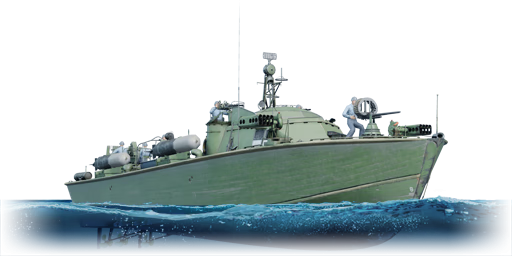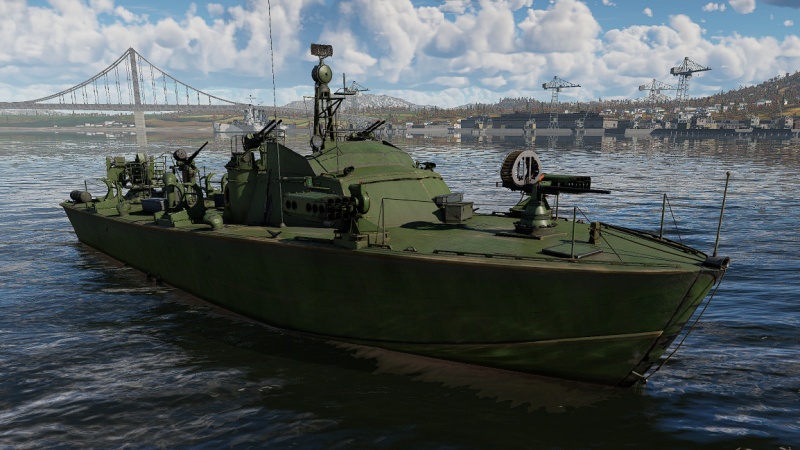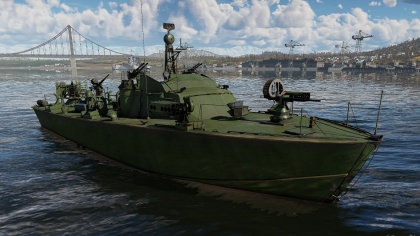Difference between revisions of "PT-200"
Inceptor57 (talk | contribs) m (→Survivability and armour) |
|||
| Line 1: | Line 1: | ||
| − | {{Specs-Card|code=us_higgins_78ft_pt625}} | + | {{Specs-Card |
| + | |code=us_higgins_78ft_pt625 | ||
| + | |images={{Specs-Card-Image|GarageImage_{{PAGENAME}}.jpg}} | ||
| + | }} | ||
== Description == | == Description == | ||
| Line 9: | Line 12: | ||
== General info == | == General info == | ||
=== Survivability and armour === | === Survivability and armour === | ||
| + | {{Specs-Fleet-Armour}} | ||
<!-- Talk about the vehicle's armour. Note the most well-defended and most vulnerable zones, e.g. the ammo magazine. Evaluate the composition of components and assemblies responsible for movement and manoeuvrability. Evaluate the survivability of the primary and secondary armaments separately. Don't forget to mention the size of the crew, which plays an important role in fleet mechanics. Save tips on preserving survivability for the "Usage in battles" section. If necessary, use a graphical template to show the most well-protected or most vulnerable points in the armour. --> | <!-- Talk about the vehicle's armour. Note the most well-defended and most vulnerable zones, e.g. the ammo magazine. Evaluate the composition of components and assemblies responsible for movement and manoeuvrability. Evaluate the survivability of the primary and secondary armaments separately. Don't forget to mention the size of the crew, which plays an important role in fleet mechanics. Save tips on preserving survivability for the "Usage in battles" section. If necessary, use a graphical template to show the most well-protected or most vulnerable points in the armour. --> | ||
As with any coastal motor torpedo boat, the PT-200's survivability is not its strength. The entire ship is made out of wood and also lacks any armour plating aside from 9.52 mm of hardened armour on the rear single Bofors 40 mm turret. The crew count of just twelve crewmembers is relatively average among Motor Torpedo Boats (MTBs), meaning that the PT-200 will not be able to take many hits as well. Keep in mind that the ship can be hull-broken by most shells of 88 mm and above; luckily, it doesn't face many ships with such high-calibre weapons. In terms of vital components, the ship's engines and ammunition magazines all lie partway above the water; this means that a lucky hit from a lower-calibre shell could potentially detonate your ammunition, resulting in a floating inferno. In general, avoid any firefights with the PT-200 as it will be decimated quickly due to its low survivability. | As with any coastal motor torpedo boat, the PT-200's survivability is not its strength. The entire ship is made out of wood and also lacks any armour plating aside from 9.52 mm of hardened armour on the rear single Bofors 40 mm turret. The crew count of just twelve crewmembers is relatively average among Motor Torpedo Boats (MTBs), meaning that the PT-200 will not be able to take many hits as well. Keep in mind that the ship can be hull-broken by most shells of 88 mm and above; luckily, it doesn't face many ships with such high-calibre weapons. In terms of vital components, the ship's engines and ammunition magazines all lie partway above the water; this means that a lucky hit from a lower-calibre shell could potentially detonate your ammunition, resulting in a floating inferno. In general, avoid any firefights with the PT-200 as it will be decimated quickly due to its low survivability. | ||
| − | === Mobility ===<!-- Write about the ship's mobility. Evaluate its power and manoeuvrability, rudder rerouting speed, stopping speed at full tilt, with its maximum forward and reverse speed. --> | + | === Mobility === |
| + | {{Specs-Fleet-Mobility}}<!-- Write about the ship's mobility. Evaluate its power and manoeuvrability, rudder rerouting speed, stopping speed at full tilt, with its maximum forward and reverse speed. --> | ||
{{NavalMobility}} | {{NavalMobility}} | ||
| + | |||
| + | === Modifications and economy === | ||
| + | {{Specs-Economy}} | ||
== Armament == | == Armament == | ||
| + | {{Specs-Fleet-Armaments}} | ||
=== Primary armament === | === Primary armament === | ||
| + | {{Specs-Fleet-Primary}} | ||
<!-- ''Provide information about the characteristics of the primary armament. Evaluate their efficacy in battle based on their reload speed, ballistics and the capacity of their shells. Add a link to the main article about the weapon: <code><nowiki>{{main|Weapon name (calibre)}}</nowiki></code>. Broadly describe the ammunition available for the primary armament, and provide recommendations on how to use it and which ammunition to choose.'' --> | <!-- ''Provide information about the characteristics of the primary armament. Evaluate their efficacy in battle based on their reload speed, ballistics and the capacity of their shells. Add a link to the main article about the weapon: <code><nowiki>{{main|Weapon name (calibre)}}</nowiki></code>. Broadly describe the ammunition available for the primary armament, and provide recommendations on how to use it and which ammunition to choose.'' --> | ||
{{main|Bofors L/60 Mark 3 (40 mm)|AN-M4 (37 mm)}} | {{main|Bofors L/60 Mark 3 (40 mm)|AN-M4 (37 mm)}} | ||
| Line 24: | Line 34: | ||
=== Secondary armament === | === Secondary armament === | ||
| + | {{Specs-Fleet-Secondary}} | ||
<!-- ''Some ships are fitted with weapons of various calibres. Secondary armaments are defined as weapons chosen with the control <code>Select secondary weapon</code>. Evaluate the secondary armaments and give advice on how to use them. Describe the ammunition available for the secondary armament. Provide recommendations on how to use them and which ammunition to choose. Remember that any anti-air armament, even heavy calibre weapons, belong in the next section. If there is no secondary armament, remove this section.'' --> | <!-- ''Some ships are fitted with weapons of various calibres. Secondary armaments are defined as weapons chosen with the control <code>Select secondary weapon</code>. Evaluate the secondary armaments and give advice on how to use them. Describe the ammunition available for the secondary armament. Provide recommendations on how to use them and which ammunition to choose. Remember that any anti-air armament, even heavy calibre weapons, belong in the next section. If there is no secondary armament, remove this section.'' --> | ||
{{main|20 mm/70 Oerlikon Mk.II (20 mm)}} | {{main|20 mm/70 Oerlikon Mk.II (20 mm)}} | ||
| Line 30: | Line 41: | ||
=== Anti-aircraft armament === | === Anti-aircraft armament === | ||
| + | {{Specs-Fleet-AA}} | ||
<!-- ''An important part of the ship's armament responsible for air defence. Anti-aircraft armament is defined by the weapon chosen with the control <code>Select anti-aircraft weapons</code>. Talk about the ship's anti-air cannons and machine guns, the number of guns and their positions, their effective range, and about their overall effectiveness – including against surface targets. If there are no anti-aircraft armaments, remove this section.'' --> | <!-- ''An important part of the ship's armament responsible for air defence. Anti-aircraft armament is defined by the weapon chosen with the control <code>Select anti-aircraft weapons</code>. Talk about the ship's anti-air cannons and machine guns, the number of guns and their positions, their effective range, and about their overall effectiveness – including against surface targets. If there are no anti-aircraft armaments, remove this section.'' --> | ||
{{main|AN-M2 (12.7 mm)}} | {{main|AN-M2 (12.7 mm)}} | ||
| Line 42: | Line 54: | ||
=== Special armament === | === Special armament === | ||
| + | {{Specs-Fleet-Special}} | ||
<!-- ''Depth charges, mines, rocket launchers and missiles are also effective in skilled hands and can take an off-guard opponent by surprise. Evaluate the ammunition of this type of armament and rate its performance in combat. If there are no special armaments, remove this section.'' --> | <!-- ''Depth charges, mines, rocket launchers and missiles are also effective in skilled hands and can take an off-guard opponent by surprise. Evaluate the ammunition of this type of armament and rate its performance in combat. If there are no special armaments, remove this section.'' --> | ||
{{main|M8}} | {{main|M8}} | ||
The M8 rockets are very situational and typically serve only to create an extra ammo rack. | The M8 rockets are very situational and typically serve only to create an extra ammo rack. | ||
| + | |||
| + | === Additional armament === | ||
| + | {{Specs-Fleet-Additional}} | ||
| + | ''Describe the available additional armaments of the ship: depth charges, mines, torpedoes. Talk about their positions, available ammunition and launch features such as dead zones of torpedoes.'' | ||
| + | |||
| + | ''If there is no additional armament, remove this section.'' | ||
== Usage in battles == | == Usage in battles == | ||
Revision as of 12:05, 29 December 2020
Contents
Description
The Higgins 78 ft PT-200 is a rank III American motor torpedo boat
with a battle rating of 2.7 (AB/RB/SB). It was introduced in Update 1.79 "Project X" as part of the fleet closed beta test.
General info
Survivability and armour
As with any coastal motor torpedo boat, the PT-200's survivability is not its strength. The entire ship is made out of wood and also lacks any armour plating aside from 9.52 mm of hardened armour on the rear single Bofors 40 mm turret. The crew count of just twelve crewmembers is relatively average among Motor Torpedo Boats (MTBs), meaning that the PT-200 will not be able to take many hits as well. Keep in mind that the ship can be hull-broken by most shells of 88 mm and above; luckily, it doesn't face many ships with such high-calibre weapons. In terms of vital components, the ship's engines and ammunition magazines all lie partway above the water; this means that a lucky hit from a lower-calibre shell could potentially detonate your ammunition, resulting in a floating inferno. In general, avoid any firefights with the PT-200 as it will be decimated quickly due to its low survivability.
Mobility
| Mobility Characteristics | |||
|---|---|---|---|
| Game Mode | Upgrade Status | Maximum Speed (km/h) | |
| Forward | Reverse | ||
| AB | |||
| Upgraded | 104 | 23 | |
| RB/SB | |||
| Upgraded | 74 | 16 | |
Modifications and economy
Armament
Primary armament
The 37 mm cannon is similar to the one mounted on the P-39s. As such it has poor accuracy but high damage. With its ability to fire for a decent time prior to over-heating, it serves as a potent close range weapons, at the cost of DPS.
Secondary armament
The 20 mm cannons serve as a potent light AA weapon and a potent anti ship weapon. They are unable to hit targets at range, however, and excel in close range brawls.
Anti-aircraft armament
Despite lacking at high BRs, as this ship will likely only face light boats and planes, the .50 cals that saturate its deck make it a potent anti-air boat. Unfortunately, like the cannons they have a short range and have poor angles of firing and depression, limiting their surface usage.
Torpedo armament
The 4 torpedoes make a potent anti-ship weapon, but due to the slowness of steam-powered torpedoes, they do not have a long range or fast speed, especially compared to the Japanese oxygen torpedo.
Special armament
The M8 rockets are very situational and typically serve only to create an extra ammo rack.
Additional armament
Describe the available additional armaments of the ship: depth charges, mines, torpedoes. Talk about their positions, available ammunition and launch features such as dead zones of torpedoes.
If there is no additional armament, remove this section.
Usage in battles
As with all PT boats, this vessel is purely a high speed cap zone taker, and close range brawler. Like a glass cannon, this boat can do serious damage with its main guns, but also can be very easily destroyed. In low tier matches, this boat serves as a potent vehicle to contest cap zones, and in higher matches, whilst destroyer hunting is not advisable due to destroyers' ability to fire at you with their secondaries using just AI, you can still win some of the vital, early game cap contests, as those early caps often determine the entire outcome of the game.
Another possible strategy for the usage of this boat is plane hunting, as in low tier battles AI anti-aircraft defences are a rarity, and the primary 40 mm cannon is devastating to aircraft if it hits. Torpedo use is also highly effective with this boat, as using a double spread of torpedoes can trap many an unsuspecting opponent. Be aware of gunboats and destroyers, their overwhelming primary and secondary armaments can easily sink your vessel, sometimes even through hull-break.
Modules
| Tier | Seakeeping | Unsinkability | Firepower | |||
|---|---|---|---|---|---|---|
| I | Dry-Docking | Tool Set | 40 mm HE clips | 20 mm HE | Anti-Air Armament Targeting | |
| II | Rudder Replacement | Fire Protection System | Smokescreen | 40 mm AP clips | 20 mm AP | Auxiliary Armament Targeting |
| III | Propeller Replacement | Rocket Launcher | Primary Armament Targeting | |||
| IV | Engine Maintenance | New Pumps | Artillery Support | |||
Pros and cons
Pros:
- Two rocket racks (8 rockets each) can be attached
- Decent firepower
- Can demolish most competitors at its BR
Cons:
- No armour and very small crew count
- Can hull break
- Expensive to repair
- Often fights well-armoured ferries
- Very weak when even slightly up-tiered
History
PT-200 was a Higgins 78-foot Motor Torpedo Boat of the United States Navy. It was laid down by Higgins Industries in New Orleans, LA, on 29 June 1942. She was launched on 16 September 1942 and completed and commissioned on 23 January 1943.
PT-200 had a length of 78 ft, a beam of 20 ft 8 in, and a draft of 5 ft 3 in. The displacement was 56 tons and it was manned by a crew of 17. The ship was powered by three 1,500 shp Packard W-14 M2500 gasoline engines, turning three shafts; a speed of 41 knots could be achieved. The armament consisted of one 20 mm gun, two twin .50 cal mounts (total of four machine guns), and four 21 inch torpedoes.
PT-200 was first assigned to Motor Torpedo Boat Squadron Four (MBTRon 4, under the command of LCDR William C. Specht, USN. MBTRon 4 was a training squadron based at the MTB Squadrons Training Center in Melville, RI. It was the largest MTB squadron, with a peak of 28 boats in the squadron at a time. PT-200 was sunk after hitting an unknown object on 22 February 1944; the location was off of Newport, RI, at 41º23'N, 71º01'W.
Media
Excellent additions to the article would be video guides, screenshots from the game, and photos.
See also
Links to articles on the War Thunder Wiki that you think will be useful for the reader, for example:
- reference to the series of the ship;
- links to approximate analogues of other nations and research trees.
External links
Paste links to sources and external resources, such as:
- topic on the official game forum;
- encyclopedia page on the ship;
- other literature.
| Higgins Industries Ships | |
|---|---|
| Patrol Torpedo Boats (PT) | |
| 81' PT Prototype | PT-6 |
| 78' PT | PT-71 · PT-200 · PT-658 · MTB-422* · MS 444** |
| *PT-92 in UK service | |
| **PT-94 in Italian service | |
| USA boats | |
|---|---|
| Motor torpedo boats | PT-3 · PT-6 · PT-20 · PT-71 · PT-103 · PT-109 · PT-174 |
| PT-200 · PT-314 · Thunderbolt (PT-556) · PT-565 · PT-658 · PT-810 · PT-811 · PT-812 | |
| Motor gun boats | Kim Qui · LCS(L)(3) · PT-59 · PTF-7 · USS Candid · USS Asheville · USS Douglas · USS Flagstaff · USS Tucumcari · USS Cyclone |
| Armoured gun boats | LCM(6) Zippo |






